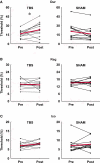Transcranial magnetic theta-burst stimulation of the human cerebellum distinguishes absolute, duration-based from relative, beat-based perception of subsecond time intervals
- PMID: 21833234
- PMCID: PMC3153783
- DOI: 10.3389/fpsyg.2010.00171
Transcranial magnetic theta-burst stimulation of the human cerebellum distinguishes absolute, duration-based from relative, beat-based perception of subsecond time intervals
Abstract
CEREBELLAR FUNCTIONS IN TWO TYPES OF PERCEPTUAL TIMING WERE ASSESSED: the absolute (duration-based) timing of single intervals and the relative (beat-based) timing of rhythmic sequences. Continuous transcranial magnetic theta-burst stimulation (cTBS) was applied over the medial cerebellum and performance was measured adaptively before and after stimulation. A large and significant effect was found in the TBS (n = 12) compared to the SHAM (n = 12) group for single-interval timing but not for the detection of a regular beat or a deviation from it. The data support the existence of distinct perceptual timing mechanisms and an obligatory role of the cerebellum in absolute interval timing with a functional dissociation from relative timing of interval within rhythmic sequences based on a regular beat.
Keywords: absolute; beat; cerebellum; duration; perception; relative; timing; transcranial magnetic theta-burst stimulation.
Figures



Similar articles
-
Dissociation of duration-based and beat-based auditory timing in cerebellar degeneration.Proc Natl Acad Sci U S A. 2010 Jun 22;107(25):11597-601. doi: 10.1073/pnas.0910473107. Epub 2010 Jun 8. Proc Natl Acad Sci U S A. 2010. PMID: 20534501 Free PMC article.
-
The Role of Posterior Parietal Cortex in Beat-based Timing Perception: A Continuous Theta Burst Stimulation Study.J Cogn Neurosci. 2018 May;30(5):634-643. doi: 10.1162/jocn_a_01237. Epub 2018 Jan 18. J Cogn Neurosci. 2018. PMID: 29346017
-
Cerebellar transcranial magnetic stimulation in psychotic disorders: intermittent, continuous, and sham theta-burst stimulation on time perception and symptom severity.Front Psychiatry. 2023 Nov 13;14:1218321. doi: 10.3389/fpsyt.2023.1218321. eCollection 2023. Front Psychiatry. 2023. PMID: 38025437 Free PMC article.
-
Safety Considerations for Cerebellar Theta Burst Stimulation.Clin Ther. 2020 Jul;42(7):1169-1190.e1. doi: 10.1016/j.clinthera.2020.06.001. Epub 2020 Jul 14. Clin Ther. 2020. PMID: 32674957
-
Neural mechanisms of rhythm perception: present findings and future directions.Adv Exp Med Biol. 2014;829:325-38. doi: 10.1007/978-1-4939-1782-2_17. Adv Exp Med Biol. 2014. PMID: 25358718 Review.
Cited by
-
Relationships between regional cerebellar volume and sensorimotor and cognitive function in young and older adults.Cerebellum. 2013 Oct;12(5):721-37. doi: 10.1007/s12311-013-0481-z. Cerebellum. 2013. PMID: 23625382 Free PMC article.
-
Timing Deficits in ADHD: Insights From the Neuroscience of Musical Rhythm.Front Comput Neurosci. 2018 Jul 6;12:51. doi: 10.3389/fncom.2018.00051. eCollection 2018. Front Comput Neurosci. 2018. PMID: 30034331 Free PMC article.
-
Time Perception for Musical Rhythms: Sensorimotor Perspectives on Entrainment, Simulation, and Prediction.Front Integr Neurosci. 2022 Jul 5;16:916220. doi: 10.3389/fnint.2022.916220. eCollection 2022. Front Integr Neurosci. 2022. PMID: 35865808 Free PMC article. Review.
-
Consensus paper: the role of the cerebellum in perceptual processes.Cerebellum. 2015 Apr;14(2):197-220. doi: 10.1007/s12311-014-0627-7. Cerebellum. 2015. PMID: 25479821 Free PMC article. Review.
-
Cerebellar contributions to verbal working memory.Cerebellum. 2014 Jun;13(3):354-61. doi: 10.1007/s12311-013-0542-3. Cerebellum. 2014. PMID: 24338673
References
-
- Bijsterbosch J. D., Lee K. H., Hunter M. D., Tsoi D. T., Lankappa S., Wilkinson I. D., Barker A. T., Woodruff P. W. (2010). The role of the cerebellum in sub- and supraliminal error correction during sensorimotor synchronization: evidence from fMRI and TMS. J. Cogn. Neurosci. [Epub ahead of print].10.1162/jocn.2010.21506 - DOI - PubMed
Grants and funding
LinkOut - more resources
Full Text Sources
Research Materials
Miscellaneous

